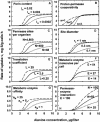Experimental and theoretical bases of specific affinity, a cytoarchitecture-based formulation of nutrient collection proposed to supercede the Michaelis-Menten paradigm of microbial kinetics
- PMID: 15345439
- PMCID: PMC520905
- DOI: 10.1128/AEM.70.9.5511-5521.2004
Experimental and theoretical bases of specific affinity, a cytoarchitecture-based formulation of nutrient collection proposed to supercede the Michaelis-Menten paradigm of microbial kinetics
Abstract
A theory for solute uptake by whole cells was derived with a focus on the ability of oligobacteria to sequester nutrients. It provided a general relationship that was used to obtain the kinetic constants for in situ marine populations in the presence of naturally occurring substrates. In situ affinities of 0.9 to 400 liters g of cells(-1) h(-1) found were up to 10(3) times smaller than those from a "Marinobacter arcticus " isolate, but springtime values were greatly increased by warming. Affinities of the isolate for usual polar substrates but not for hydrocarbons were diminished by ionophores. A kinetic curve or Monod plot was constructed from the best available data for cytoarchitectural components of the isolate by using the theory together with concepts and calculations from first principles. The order of effect of these components on specific affinity was membrane potential > cytoplasmic enzyme concentration > cytoplasmic enzyme affinity > permease concentration > area of the permease site > translation coefficient > porin concentration. Component balance was influential as well; a small increase in cytoplasmic enzyme concentration gave a large increase in the effect of permease concentration. The effect of permease concentration on specific affinity was large, while the effect on K(m) was small. These results are in contrast to the Michaelis-Menten theory as applied by Monod that has uptake kinetics dependent on the quality of the permease molecules, with K(m) as an independent measure of affinity. Calculations demonstrated that most oligobacteria in the environment must use multiple substrates simultaneously to attain sufficient energy and material for growth, a requirement consistent with communities largely comprising few species.
Figures





References
-
- Amdur, I., and G. G. Hammes. 1966. Chemical kinetics, principles and selected topics. McGraw-Hill, New York, N.Y.
-
- Berg, H. C. 1988. A physicist looks at bacterial chemotaxis. Cold Spring Harbor Symp. Quant. Biol. 53:1-9. - PubMed
Publication types
MeSH terms
Substances
LinkOut - more resources
Full Text Sources

